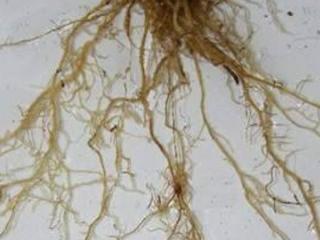Root lesion and burrowing nematodes
Nematodes are common soil pests that feed on the roots of a wide range of crop plants in all agricultural areas of Western Australia, irrespective of soil type and rainfall. Nematodes multiply on susceptible hosts. Consequently, as nematode populations increase, crop production is limited. Damaged roots have less efficient water and nutrient uptake, and plants are also less able to tolerate other stresses such as drought. Cereal yield losses due to nematodes in Western Australia are in the order of 5-15% per annum, but individual losses as high as 40% have been recorded. You can request a copy of Bulletin 4698 'Root lesion and burrowing nematodes' from Ciara Beard.
Summary of management for root lesion nematode (RLN)
Symptoms of root lesion nematode are:
- RLN can be managed with rotations and other agricultural practices, but cannot be eradicated.
- If a nematode problem is suspected, use diagnostic services to determine not only the levels, but also the species, of RLN present.
- Monitor nematode levels and maintain low populations by using appropriate rotations.
- Use resistant crops to reduce nematode numbers.
- Cereals are not resistant, but there is useful variation between cultivars (particularly for P. neglectus), see the latest wheat variety guide.
- Consider the impact of RLN on the current crop as well as on subsequent crops in the rotation.
- Crops resistant to one RLN species will not necessarily be resistant to all.
- Weeds can allow build-up and carry-over of nematodes: wild oat, barley grass, brome grass and wild radish are susceptible to P. neglectus.
- Manage volunteer susceptible crop plants that can harbour nematodes.
- Ensure adequate nutrition (especially nitrogen, zinc and phosphorus), as this will enable crops to better tolerate nematode infection.
- Recent research papers are available online - Root lesion nematode has a picnic in 2013 and Pratylenchus teres - WA's home grown root lesion nematode.
Summary of management for burrowing nematode
Further testing is required to identify crops and cultivars that will be useful in reducing soil populations of burrowing nematode and to quantify the damage caused by these nematodes.
- Burrowing nematode has been recorded in a range of wheat and barley cultivars, and can reach high levels (leading to significant damage) in these plants.
- Where burrowing nematode occurs, there is potential for high populations to develop under intensive cereal cropping. Rotations incorporating narrow-leafed lupin should be monitored. Although these nematodes may not reduce yield of narrow-leafed lupin crops, they could build-up and affect subsequent cereal crops.
- Soil and/or plant tests should be performed to discriminate between RLN and burrowing nematode damage to plants.
- Similarly, diagnosis and/or investigation of root systems may be needed to differentiate between rhizoctonia and burrowing nematode if distinct patches of poor growth are evident in cereal crops.
Diagnosis
To determine whether a nematode infestation is affecting a crop, first look at the distribution of symptomatic plants throughout the whole crop. Next, carefully dig up samples of apparently diseased as well as healthy plants. Thoroughly wash the soil from the roots and examine them for the indicative symptoms described in the Bulletin. Symptoms of root lesion nematode are described on our MyCrop page which includes a video clip to assist with diagnosis.
DDLS - Plant pathology services can assist with diagnosis, this is a chargeable service. Do not send washed plants to the laboratory. To obtain submission forms and full sampling instructions contact your local Department of Agriculture and Food, Western Australia (DAFWA) office or find information online on the DDLS - Plant pathology services or you can contact the labs by phone on +61 (0)8 9368 3721. Two types of test are available for diagnosing nematode infestations:
Growing season tests can be carried out on affected plants and associated soil. Live nematodes are extracted, counted and identified in the laboratory. Instructions for submiting representative plant samples can be found on the DDLS - Plant pathology services.
Soil and root testing can be used to define the problem and determine the species of nematode present within and outside of the growing season. Instructions for submiting representative soil samples can be found on the DDLS - Plant pathology services.
Pre-season PreDicta-B™ test uses DNA assessment to identify the species and numbers of P. neglectus and P. thornei. While this test is able to detect P. neglectus, the predominant RLN in WA cropping paddocks, other species of RLN and burrowing nematode cannot, at this stage, be assessed by this method. Results therefore need to be interpreted with caution and reconciled with paddock observations and rotation history.
PreDicta-B™ test kits are available through accredited agronomists and re-sellers.
Further information
For further information on management and illustrations of symptoms you can request a copy of Bulletin 4698 from Ciara Beard.

